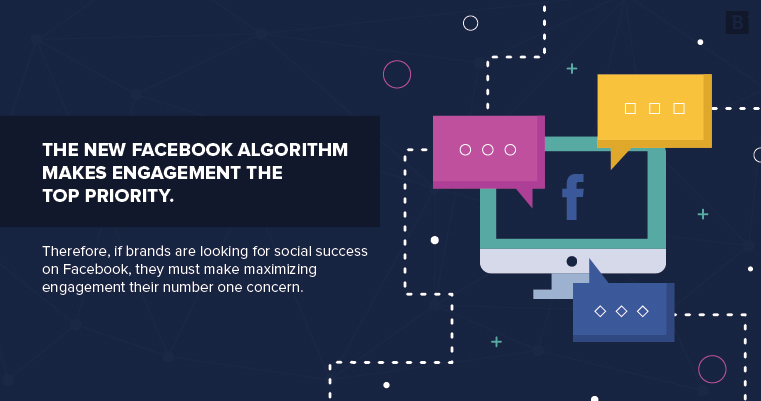Anyone in social marketing knows Facebook is changing its news feed algorithm, as businesses continue to see a decrease in organic reach and interaction.
What’s contributed to these consistent declines that brands are experiencing? There are three main factors:
- A countless number of business pages producing too much content for too many fans has intensified the competition for visibility.
- Too much content is being published across both business and personal pages, making it incredibly difficult to stand out.
- Facebook is shifting to appease and meet the demands of users who want to see content that is most relevant to them.
Knowing all this information, you might think the new algorithm is a death sentence for brands on Facebook, but that doesn’t have to be the case. Even with these changes, Facebook still offers one of the best returns on investment for marketers based on its user base.
Besides, since your customers are already on Facebook, shouldn’t you be too?
Staying relevant as a brand with the new Facebook algorithm is still certainly possible, but it will require some changes to your social content strategy in order to boost organic performance. Here are six tips that can help do just that:
1. Don’t be a beggar, be a discussion-starter
Facebook has made it a priority to seek out, reject and remove posts determined to be “engagement bait.” Marketers can no longer use posts that outright ask users for comments, tags or likes. These will quickly be flagged as spam. So how can marketers increase engagement and interaction without their content being perceived as spam?
One of the best things you can do is simply start a conversation, and don’t be afraid to get creative. Consider creating a poll for your audience, but make sure you let them lead the discussion. Inserting questions into your posts is a good idea for encouraging comments without begging, and posting controversial content is another solid tactic for creating debate. However, it’s extremely important to tread lightly when doing so, as not to offend or alienate members of your audience.
However you choose to create social conversation is ultimately up to you, but at the end of the day it’s essential you do so. The more conversation you create, the more likely Facebook will feature your content organically.
2. Fewer links, more visuals
Facebook has made it clear that it wants brands to keep their content on the platform rather than linking to an external website. Now it’s important to note that sticking to your strategy of continuing to post links won’t cause your company page to fully disappear from news feeds, but you should make it a priority to keep your feed fresh with different forms of content.
Posting link after link simply won’t perform well with the new algorithm, but it’s also just a poor social marketing strategy. After all, visual content earns 87 percent more engagement on social. This statistic alone is reason enough to determine that each and every post should be accompanied by some sort of visual. So whether it’s a graphic, a gif or an eye-popping photograph, utilizing any form of visual content with your posts is an engagement-booster.

3. It’s time for video
Now is the time for marketers to make video a part of their social strategy, if they haven’t already. Videos on Facebook are great for starting a conversation and make visitors more likely to stop on your post. According to quintly, native Facebook videos have a 186 percent higher engagement rate, and are shared over 1,000 percent more than those linked from other sites.
Besides standard video content, live video is another engagement-driver for brands on Facebook, with users spending triple the amount of time watching live videos. This can be attributed to brands utilizing the live video tool as a means of sharing authentic, behind-the-scenes content that allows them to attract and interest viewers. The format also provides a more personalized feel, giving individuals the ability to interact with brands they care about in real time. An added bonus to utilizing live video is that Facebook will send a notification to all of your followers, really helping your content stand out.
When it comes to video, you don’t have to outsmart the algorithm because you’re giving Facebook exactly what it wants. With so many options available and Facebook’s desire for more visual content, implementing video into your social strategy is a no-brainer.
4. Make each post stand apart
The days of “post and pray” are no more. From here on out each post that you create should be targeted to a specific audience, regardless if it’s an organic or paid post. Besides ensuring posts are targeted to a specific audience, it’s important to craft a unique description for each new post on the company page in order to avoid repetition. Consider using quotes, tags or questions to individualize your posts and make them stand out.
If you’re struggling to create fresh new content, don’t be afraid to repurpose older pieces. Use videos, social images, charts or even infographics to present old content in a new way. Nobody wants to be shown the same content over and over again, so providing people with content in a new form can help to increase engagement.
5. It’s all about timing
The new Facebook algorithm makes engagement the top priority. Therefore, if brands are looking for social success on Facebook, they must make maximizing engagement their number one concern. So how can marketers look to achieve this? The answer is simple: stick to a content calendar with your brand’s best times to post. With a little bit of research, you can determine what days and times are the best for your page’s performance. Taking that information and building out a content calendar for scheduling your posts can do wonders for boosting your brand’s social performance.
It is important to remember that time reports aren’t the end-all be-all for when exactly to post, but it will shed some light on when your audience is typically online and most active. After all, anything to boost being seen by more followers is always a plus.
6. Have you tried paid?
Offering marketers freedom unlike any other ad platform, there’s no denying the power of Facebook ads. While brands should certainly focus on improving their organic reach, you can’t deny the data which shows an overwhelmingly positive ROI with 93 percent of marketers already reaping the benefits of the Facebook ads platform.
Discover the abilities of the platform, and create a video ad that’ll catch your followers’ eyes. Maybe give carousel ads a try, which have a history of great performance and a low CPC. Facebook’s paid platform offers many options to marketers, and when partnered with your organic efforts, it gives you the best of both worlds. Paid ads help to set your brand up for social success now, and in the future.
Final thoughts
Regardless of how you feel about the updated Facebook algorithm, it’s forcing marketers to reassess their social content strategies. Ultimately, it will be those who can best align their strategies with Facebook’s best practices that will reap the benefits of social media glory.





